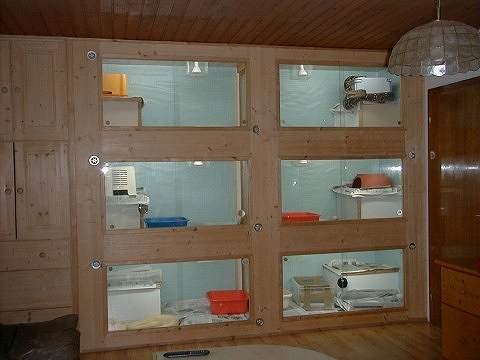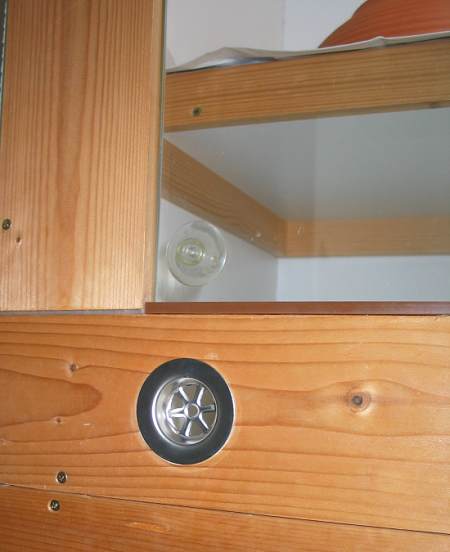Dimensions of a boa tank / terrarium / enclosure / cage
We are often asked what dimensions an boa constrictor terrarium must have to house a snake of a particular size.
The Federal Department of Agriculture and Forestry in Germany has consulted a group of “animal protection and captive husbandry experts” to get an expert opinion on the "minimum requirements for the captive husbandry of reptiles". The measures for Boa constrictor were determined as follows:
| Genus | Size of the terrarium (in regards to the total length of the snake) |
|---|---|
| Boa constrictor smaller than 1,5 m | 1,0 x 0,5 x 0,75 (Length x Depth x Height) |
| Boa constrictor larger than 1,5 m | 0,75 x 0,5 x 0,75 (Length x Depth x Height) |
For better understanding, here an example: You have a Boa constrictor of 1,60m (over 5 ft) in length.
The measurements of the enclosure are then calculated as follows:
1,60 m x 0,75 = 1,20 m (length of the enclosure);
1,60 m x 0,5 = 0,80 m (depth of the enclosure);
1,60 m x 0,75 = 1,20 m (height of the enclosure).
These calculations are valid for two specimen of that size, which can then be kept together in one enclosure of the determined size.
It should be added that this expert opinion has not yet been implemented into the legislature, and can therefore only serve as recommendation at this point. We would also like to mention that we consider these values to be overkill, especially in regards to height, even though the maximum height given is 2 meters (over 6.5 ft).
 Vivarium in the living room The materials for the boa tank / terrarium / enclosure / cage
Vivarium in the living room The materials for the boa tank / terrarium / enclosure / cage
A glass cage for boas and pythons makes sense only if the room, in which the enclosure is located, is heated to the necessary temperature (up to 30° Celsius). Otherwise, and we wish to emphasize this strongly, this material is useless. A glass enclosure that is located in a cool room and heated separately is unable to retain heat, due to the lack of insulation. The heating source will therefore run non-stop. This leads to a large consumption of energy and also lowers the humidity to a percentage at which it may be harmful to the health of the animal.
We therefore recommend bright, coated wood sheets (19 mm) with a front made of natural wood and generously sized sliding doors (6 mm). An enclosure made from these materials retains heat relatively well, while urine and feces are easy to remove, since the coating keeps it from penetrating the wood.
boa constrictor terrarium size | boa constrictor tank | boa constrictor cage | terrarium lighting | terrarium heating | boa terrarium heating cable | boa terrarium heating pads | boa terrarium ventilation | Boa constrictor terrarium materials | terrarium substrate | terrarium climbing branches | terrarium plants | tank hide spots | Terrarium humidity gauge | terrarium thermometer
Ventilation of the boa tank / terrarium / enclosure / cage
Boas and pythons require significantly less oxygen (unless they are digesting a large prey item) than mammals. Therefore, large sized terrarium vents are not necessary, since too much ventilation places a burden on the humidity, as the heat source has to operate more frequently.
The vents can be made by ways of mesh or by simple drill-holes. Best suitable for this are the sidewalls of the enclosure. The physical law of warm air rising and cool air sinking has to be considered here.
 A simple drain filter makes an excellent lock for the
A simple drain filter makes an excellent lock for the
ventilation opening of the enclosure. We even think, that this doesn't look bad.
Hence, the vent that is closest to the heat source should be placed towards the bottom, while the one on the other side should be placed towards the top of the enclosure wall.
Divider in the boa tank / terrarium / enclosure / cage
A removable divider in the enclosure is not a requirement, but very practical when housing several specimen in one enclosure, as boids should generally be separated during feeding.
Wire mesh on a hinged wooden frame that can be folded to the side when unlocked is best suitable for this. But even a design, in which the divider can be pulled out from the front, or unhinged like a sliding door is possible. There are no limits set to the imagination of the handymen.
 The divider can be removed like a front glass. It has just to be lifted a little bit and it can already be removed.
The divider can be removed like a front glass. It has just to be lifted a little bit and it can already be removed.
